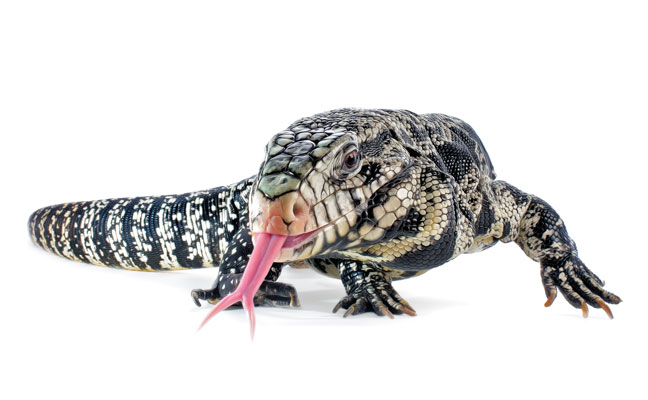
Photo: Bob_Eastman / iStock / Getty Images Plus / Getty Images
Tegus, specifically the Argentine black and white species (Salvator merianae), have been making headlines this year in Florida and Georgia — scaring homeowners by taking up residence under a back porch, for example. These “dog-sized lizards” are desirable pets among reptile enthusiasts, but several established populations are being found in the wild.
Tegus mostly feed on the eggs of chicken, quail and turkeys. They also eat the eggs of American alligators (Alligator mississippiensis) and gopher tortoises (Gopherus polyphemus), both of which are protected species. Fruit, vegetables, plants, pet food, carrion, and small live animals such as grasshoppers and young gopher tortoises are also common tegu food options.
Native to Brazil, Paraguay, Uruguay and Argentina, these lizards can grow up to 4 feet long, weigh more than 10 pounds and can live up to 20 years. Other features, per the Georgia Department of Natural Resources’ Wildlife Resource Division, include:
- Coloring is black to dark gray, with white speckled bands across the back and tail.
- Hatchlings have bright green on their heads, a coloration that fades at about 1 month old.
- Sizes vary by age. Hatchlings can be about 6 to 8 inches long. Adults documented in the wild in Georgia have averaged slightly less than 2 feet.
- Tegus are active by day but are rarely found more than a few feet off the ground.
- They are strong swimmers and can stay submerged for extended periods.
- Tegus occupy mixed grassland/woodlands and disturbed habitats such as forest clearings, fence rows and roadsides.
- They overwinter in burrows or under cover in a hibernation-like state called brumation.
- Females reach reproductive age at about 12 inches long, or after their second season of brumation. They can lay about 35 eggs a year, typically hatching in the Southeastern U.S. in June or July.
- Although they are not considered aggressive toward people, tegus will defend themselves if threatened. They can react fast and lash with their tails. They have sharp teeth and claws, and strong jaws.
- Tegus can be mistaken for native reptiles such as juvenile alligators (which are protected), broadhead skinks (Plestiodon laticeps) and eastern fence lizards (Sceloporus undulatus). That said, adult native lizards are usually no larger than a hatchling tegu.
Like other reptiles, tegus can carry Salmonella. There is concern it can spread parasites to native wildlife and cause bacterial contamination in crops. In 2022, the U.S. Geological Survey published two studies that concluded this invasive species is adaptable enough to colder temperatures that it could spread rapidly throughout the Southeastern U.S., and even beyond.
Wildlife researchers recommend removing tegus through live trapping and taking them to your local department of wildlife for evaluation, although lethal measures are allowed depending on location and situation. For customers in areas where wild tegus are established, following rodent and wildlife prevention tactics works well: Recommend that customers keep pet food indoors and landscaping manicured so there are fewer harborage areas, for example.
REFERENCES
- GeorgiaWildlife.com/tegus, accessed Nov. 15, 2023
- USGS.gov/news/state-news-release/new-research-verifies-invasive-tegu-lizards-adaptable-various-climates, accessed Nov. 15, 2023
- MyFWC.com/wildlifehabitats/profiles/reptiles/argentine-black-and-white-tegu, accessed Nov. 15, 2023
Leave A Comment